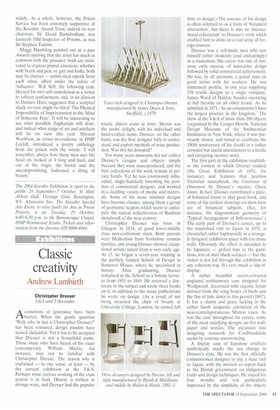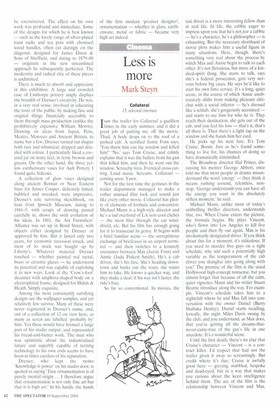Classic creativity
Andrew Lambirth
Christopher Dresser V&A until 5 December
Accusations of ignorance have been hurled. When the gentle question 'Well, who in fact is Christopher Dresser?' has been ventured, design pundits have turned disdainful. Yet it has to be accepted that Dresser is not a household name. Those many who have heard of his exact contemporary William Morris, for instance, may not be familiar with Christopher Dresser. The reason why is explained — in one sense, at least — by the current exhibition at the V&A. Perhaps some curious working of the class system is at fault. History is written in strange ways, and Dresser had the popular touch, almost avant la lettre. Morris was the snobs' delight, with his individual and hand-crafted items. Dresser, on the other hand, was the first designer fully to understand and exploit methods of mass production. Was this his downfall?
For many years museums did not collect Dresser's designs and objects simply because they were mass-produced, and the best collections of his work remain in private hands. Yet he was enormously influential, single-handedly inventing the position of commercial designer, and worked in a dazzling variety of media and materials. Some of his more minimal designs have become classics, among them a group of geometric teapots which seem to anticipate the radical reductiveness of Bauhaus metalwork of the next century.
Christopher Dresser was born in Glasgow in 1834, of good lower-middle class non-conformist stock. Both parents were Methodists from Yorkshire yeoman families, and young Dresser showed exceptional artistic talent from a very early age. At 13, he began a seven-year training at the publicly funded School of Design in Somerset House, where he specialised in botany. After graduating, Dresser remained at the School as a botany lecturer from 1855 to 1869. He received a doctorate in the subject and wrote three books on it, in addition to the many publications he wrote on design. (As a result of not being awarded the chair of botany at University College. London. he turned full time to design.) The essence of his design is often referred to as a form of 'botanical abstraction', but there is also an 'international eclecticism' to Dresser's work which enabled him to draw on a vast array of foreign sources.
Dresser was a self-made man who saw himself rather modestly (and endearingly) as a tradesman. His career was one of runaway early success, of innovative design followed by solid commercial achievement. He was, by all accounts, a genial man on good terms with his workers. He was immensely prolific, in one year supplying 158 textile designs to a single company, James Ward of Halifax, besides operating at full throttle on all other fronts. As he admitted in 1871, 'As an ornamentist I have the largest practice in the kingdom.' The show at the V&A of more than 200 objects (organised by the Cooper-Hewitt, National Design Museum, of the Smithsonian Institution in New York, where it was previously shown, and timed to celebrate the 100th anniversary of his death) is a rather crowded but useful introduction to a fertile and intriguing creative mind.
The first part of the exhibition establishes the context in which Dresser studied (the Great Exhibition of 1851, for instance) and features that peerless Victorian sourcebook, the Grammar of Ornament by Dresser's mentor. Owen Jones. In fact. Dresser contributed a plate, of botanical forms to that great book, and some of the earliest drawings on show here are of botanical subjects. (See, for instance, the diagrammatic geometry of 'Typical Arrangement of Inflorescences'.) The early part of Dresser's career, up to the watershed visit to Japan in 1876, is chronicled rather haphazardly in a strangely designed exhibition space with too many walls. Obviously the effect is intended to be Japanese — grilled tops to the partitions, lots of matt black surfaces — but the visitor is not led through the exhibition in any coherent way. It's very much a 'dip in display.
A rather beautiful cream-coloured unglazed earthenware vase designed for Wedgwood, decorated with organic forms derived from the wing bones of birds and the fins of fish, dates to this period (1867). It has a charm and grace lacking in the rather harsh turquoise coloration of the near-contemporaneous Minton vases. As was the case throughout his career, some of the most satisfying designs are for wallpaper and textiles. The excursion into designing ironwork for Coalbrookdale seems by contrast unconvincing.
A display case of Japanese artefacts symbolically marks the sea change in Dresser's style. He was the first officially commissioned designer to pay a state visit to Japan, with the mission to report back to the British government on indigenous crafts and design techniques. He stayed for four months and was particularly impressed by the simplicity of the objects he encountered. The effect on his own work was profound and immediate. Some of the designs for which he is best known — such as the lovely range of silver-plated toast racks and tea pots with ebonised wood handles, often cut daringly on the diagonal, designed for James Dixon & Sons of Sheffield, and dating to 1879-80 — originate in the new streamlined approach he subsequently perfected. The modernity and radical chic of these pieces is undimmed.
There is much to absorb and appreciate in this exhibition. A large and crowded case of Linthorpe pottery amply displays the breadth of Dresser's creativity. He was, in a very real sense, involved in educating the taste of the public, by making fine and original things financially accessible to them through mass production (unlike the prohibitively expensive William Morris). Drawing on ideas from Japan, Peru, Mexico, Morocco and Ancient Britain, to name but a few, Dresser turned out shapes both rare and whimsical, dripped and drizzled with colour. I particularly liked a covered jar on many feet, in ferny browns and greens. On the other hand, the three yellow earthenware vases for Ault Pottery I found quite hideous.
A collection of glass vases designed along ancient Roman or Near Eastern lines for James Couper, delicately tinted, bubbled and streaked, were impressive. Dresser's sole surviving sketchbook, on loan from Ipswich Museum, dating to 1861-5, with scraps of drawing pasted carefully in, shows the swift evolution of his ideas. In 1881, the Art Furnishers' Alliance was set up in Bond Street, with objects either designed by Dresser or approved by him. But it lasted only two years, for economic recession struck, and most of its stock was bought up by Liberty's. Whatever material Dresser touched — whether painted red metal, brass or ceramic glazes — he understood its potential and was capable of exploiting it in new ways. Look at the 'Crow's-foot' decanter with amphora-shaped body on a electroplated frame, designed for Hukin & Heath. Simply exquisite.
Among the most consistently satisfying designs are the wallpaper samples, and yet relatively few survive. Many of these were never registered in Dresser's name, and, out of a collection of 12 on view here, as many as seven are labelled 'probably by' him. Yet these would have formed a large part of his studio output, and represented his bread-and-butter work. The man who was optimistic about the industrialised future and superbly capable of turning technology to his own ends seems to have been at times careless of his reputation.
Dresser, who kept the motto 'Knowledge is power' on his studio door, is quoted as saying 'True ornamentation is of purely mental origin ... I therefore argue that ornamentation is not only fine art but that it is high art.' In his hands, the hands of the first modern 'product designer', ornamentation — whether in glass, earthenware, metal or fabric — became very high art indeed.



















































































 Previous page
Previous page